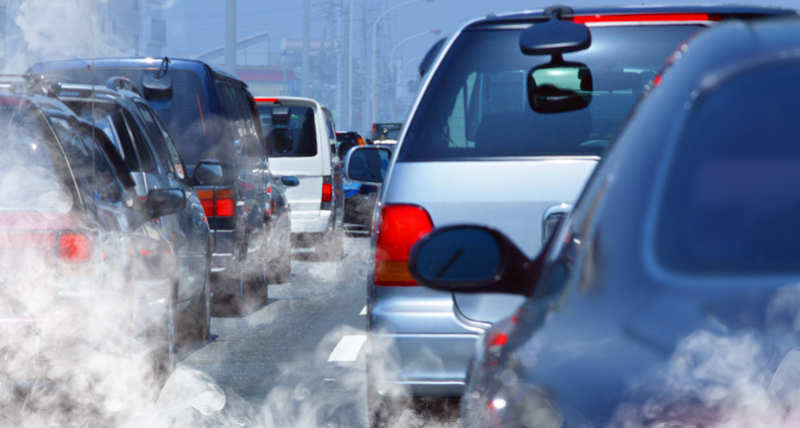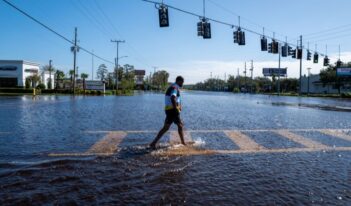
Scholar argues that federal air laws conceal highly polluted areas.
The Clean Air Act promotes cleaner air, but for whom?
Although the Clean Air Act has lowered levels of air pollution in the United States, at least one scholar maintains that the law masks areas of intense pollution.
In a recent article, Ann Carlson, a professor at the University of California, Los Angeles School of Law, argues that the Clean Air Act’s approach to regulating air quality ignores an important issue: the existence of “hotspots,” small areas of highly polluted air.
Congress passed the Clean Air Act decades ago, requiring the U.S. Environmental Protection Agency (EPA) to regulate emissions of pollutants that threaten the public health. Specifically, the law tasks EPA with creating and enforcing federal air quality standards for six air pollutants at levels necessary to protect the public health, welfare, and environment.
When an area meets EPA’s standards, the agency labels the area as “in attainment.” Residents of an area in attainment with national standards may, understandably, infer that the air that they breathe is clean. Conversely, residents of an area not in attainment may assume that the air quality in their neighborhood is unhealthy to breathe.
But at least some of these residents—whether in attainment or “nonattainment” areas—would often be wrong, argues Carlson.
EPA’s air quality standards apply to large geographical areas, and the air quality within these large areas is not uniform—variation exists from one locale to another. Carlson argues that these differences are not always captured by the few monitoring stations used to measure the air quality of any one zone.
For instance, Carlson notes that one district in Southern California, which is 10,743 square miles and includes 18 million people, is classified as an extreme nonattainment zone for ozone. But monitoring stations in the district consistently show that its eastern side has much higher levels of pollution than does its western side. In 2016, for instance, West Los Angeles did not violate the ozone standard even once, while San Bernardino had 26 violations.
On the other hand, Carlson shows that hotspots abound in parts of areas that are declared to be in attainment with federal standards. Neighborhoods downwind from highways in Denver and Memphis, for example, often experience highly polluted air, dirtier than air in some extreme nonattainment areas. Neighborhoods located around oil refineries and chemical plants in Torrance, California and Houston are often in the same boat.
To complicate matters further, Carlson emphasizes that hotspots harm communities of color and low-income communities disproportionately. These communities are more likely to be located around polluting stationary sources, such as oil refineries, as well as near busy highways.
Carlson argues that because air pollution is masked in certain locales, members of the public—especially disadvantaged communities—lack critical information about the health risks that they face. And if members of the public lack information about a public health problem, they may not push EPA to meet their needs.
Under President Barack Obama’s EPA, Carlson explains, the federal government introduced new strategies to combat hotspots through regulation. For instance, EPA increased the number of monitors that track air pollution next to roads. EPA also created a new standard for nitrogen dioxide that targets communities located near highways and oil refineries. In addition, EPA altered its system for determining emissions from oil refineries after the agency found that its prior method underestimated emissions.
Despite these government initiatives, Carlson argues that the Clean Air Act has structural limitations that make it difficult for the federal government and states to combat hotspots. For one, although states must design their own plans for compliance with federal air quality standards, they lack meaningful authority to regulate mobile emissions, like pollution from motor vehicles—one of the leading causes of hotspots. As a result, states generally focus on limiting stationary source emissions, like emissions from oil refineries, rather than emissions from motor vehicles. Furthermore, the Clean Air Act strongly encourages states to use enforceable, direct measures to achieve attainment with federal air quality standards, which are generally imposed on stationary sources, not mobile sources.
Carlson offers a few possible solutions to the issue of hotspots and thus the issues caused by their disproportionate impacts on low income communities and communities of color. First, she notes that government regulatory schemes that tackle greenhouse gas emissions would help to reduce hotspot pollution. More specifically, some scholars suggest that transitioning to an electric fleet of vehicles would reduce both mobile source emissions as well as stationary source emissions, as there would be a reduced need for fossil fuel power plants and oil refineries. Second, Carlson explains that transitioning in the power sector from fossil fuels to renewable energy sources would curb pollution from stationary sources.
In addition, states can respond in immediate ways to mitigate the impact of hotspots, Carlson demonstrates. States can control transportation and traffic flow, offer public transportation with reduced emissions, and support carpooling with designated highway lanes. In addition, states can adopt an “indirect source review,” which is permitted but not required by the Clean Air Act, to bring highways and development areas into compliance with federal air quality standards.
Ultimately, Carlson shows that, by reducing the impact of hotspots, states and the federal government could profoundly impact the lives of those who live near highways, factories, and refineries, many of whom are not aware of the risks to their health posed by nearby emissions sources.
Carlson’s paper appears in the UCLA Law Review.



